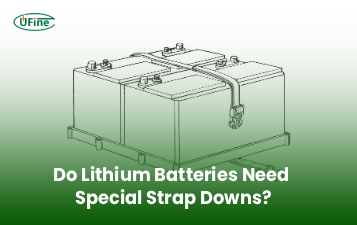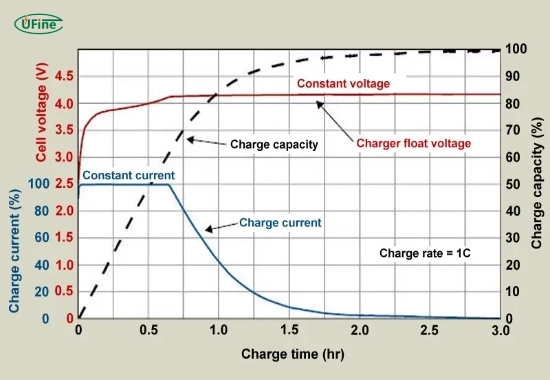
Properly charging a 24V lithium battery is essential for optimal functionality and safety. Following this guide’s guidelines and best practices, you can harness your battery’s full potential, ensuring long-lasting power for your applications.
Part 1. How to charge a 24 volt battery: Step-by-step guide
- Check Battery Voltage: Ensure the battery is a 24V system (nominal voltage 25.6V for lithium).
- Select Compatible Charger: Use a charger with 27-30V output and CC/CV mode.
- Connect Terminals Safely: Red to positive (+), black to negative (-).
- Monitor Charging Process: Avoid temperatures above 45°C (113°F).
- Disconnect When Full: Most lithium batteries auto-stop at 29.2V.
Part 2. Key factors for efficient 24 volt battery charging
When learning how to charge a 24 volt battery, the charging voltage and current are critical factors. A proper 24V lithium battery charger should deliver 27-30 volts, with precise control to match the battery’s state of charge. For example, a fully depleted 24V LiFePO4 battery requires a constant current (CC) phase at 0.5C (e.g., 50A for a 100Ah battery) until reaching 28.8V, followed by a constant voltage (CV) phase at 29.2V. Always refer to the manufacturer’s specifications to avoid overcharging risks.
1. Charging Voltage and Current
Determining the correct charging voltage and current is vital to maintaining the health and longevity of your battery. Following the manufacturer’s recommendations and specifications in the battery’s user manual is crucial. Deviating from these guidelines may lead to overcharging or undercharging, adversely affecting the battery’s performance.
For a 24V lithium battery (actual nominal voltage 25.6V), the charging voltage should be set to 29.2±0.2V. Chargers labeled “29V output” are ideal for charging 24 volt battery systems.
2. Charge Controller Selection
Using a suitable charge controller is essential, especially for solar-powered systems. Charge controllers regulate the current flow from the solar panels to the battery, preventing overcharging and optimizing charging efficiency. Ensure you choose a controller compatible with 24V lithium batteries for maximum effectiveness.
3. Temperature Considerations
Temperature plays a significant role in the charging process. Extreme temperatures, whether too hot or too cold, can significantly impact the performance and overall lifespan of the battery. Charging your 24V lithium battery within the optimal temperature range specified by the manufacturer is advisable.
4. Charging Cycles and Depth of Discharge
Lithium batteries perform best when subjected to partial rather than complete charging and discharging cycles. Avoid frequent deep discharges, impacting the battery’s overall capacity and longevity. Maintaining a moderate depth of discharge and following the manufacturer’s guidelines on charging cycles will help maximize the battery’s lifespan.
Part 3. Charging Methods for 24V Lithium Batteries
For charging 24 volt battery systems, constant voltage charging is the most reliable method. Set your charger to 29.2V (±0.2V) for standard lithium-ion batteries, maintaining this voltage until the current drops to 3-5% of the battery’s capacity (e.g., 3A for a 100Ah battery). This two-stage CC/CV charging ensures 95% efficiency while preventing thermal runaway. Solar users should pair this with an MPPT controller rated for 30A minimum.
1. Constant Voltage Charging
Constant voltage charging is a widely used method for charging lithium batteries. This approach applies a continual voltage slightly above the battery’s nominal voltage until it reaches its maximum charge capacity. Once the battery reaches full charge, the charging current gradually decreases. This method is efficient and ensures a safe charging process, preventing overcharging.
2. Trickle Charging
Trickle charging is a slow charging method that provides a low current to the battery over an extended period. It is often used for long-term battery maintenance, ensuring the battery remains fully charged without overcharging. This method offers benefits for applications where the battery sees infrequent use or for storing the battery for an extended period.
3. Fast Charging
Fast charging is gaining popularity due to its ability to charge a lithium battery rapidly. However, fast charging should be approached with caution, as it can generate heat and potentially reduce the battery’s lifespan. It is essential to select a charger specifically designed for fast charging and follow the manufacturer’s guidelines to prevent any adverse effects.
4. Smart Charging
Smart or intelligent charging utilizes advanced charging algorithms and circuitry to optimize charging. These chargers monitor the battery’s voltage, temperature, and other parameters to deliver the ideal charging profile. Smart chargers protect your 24V lithium battery from overcharging, overheating, and other potential risks, ensuring maximum efficiency and battery longevity.
Part 4. Charging 24V Lithium Battery Best Practices
Regular Maintenance
Perform regular maintenance checks on your battery, including cleaning the terminals and ensuring proper connections. This helps maintain optimal charging efficiency.
Avoid Overcharging and Undercharging
Overcharging can lead to premature battery failure while undercharging can reduce capacity. Follow the manufacturer’s recommendations and use appropriate charging equipment to prevent these issues.
Monitor Charging Process
Keep an eye on the charging process and avoid leaving the battery unattended for extended periods. Regularly check the battery’s temperature and voltage during charging to ensure everything is within the recommended range.
Proper Storage
If you need to store your 24V lithium battery for an extended period, charge it to around 50% of its capacity. Store it in a cool, dry place away from direct sunlight and extreme temperatures.
Use Genuine Chargers
Always use chargers and accessories recommended by the battery manufacturer. Substandard chargers can compromise the charging process and potentially damage the battery.
Part 5. FAQs about charging 24 volt battery
Can a 12-volt charger charge a 24-volt battery?
No, a 12V charger cannot safely charge a 24V battery. The voltage mismatch prevents proper charging and may damage both the charger and battery.
What is the charging voltage for a 24-volt lithium battery?
The ideal charging voltage is 29.2V for most 24V lithium batteries, with a tolerance of ±0.2V. This applies during the constant voltage (CV) phase.
How to charge a 24 volt battery with a solar panel?
Follow these steps:
- Use a 24V solar panel array (e.g., 2×12V panels in series).
- Connect through an MPPT charge controller (30A minimum).
- Set controller to lithium mode with 29.2V absorption voltage.
- Monitor daily charge cycles to maintain 20-80% state of charge.
Can I use a car alternator to charge a 24V battery?
Yes, but only with a DC-DC booster converting 12V to 29.2V. Direct connection will undercharge the battery and strain the alternator.
How long does it take to charge a 24V 100Ah battery?
With a 20A charger: 5 hours (0% to 100%). A 50A charger reduces this to 2 hours, but avoid exceeding 0.5C rate for lithium batteries.
Related Tags:
More Articles

Do Lithium Batteries Require Special Strap Downs? (Safety + Vibration Control)
Discover why lithium batteries require special strap downs to prevent vibration damage, terminal stress, and internal component issues.
Battery Strap Down Safety Tips: Preventing Vibration Damage and Terminal Stress
Follow these expert battery strap down safety tips to prevent vibration damage, terminal stress, and ensure LiFePO4 battery longevity.
How to Choose a Good 18650 Battery with Reliable Quality?
Battery quality defines performance and safety. Ufine Battery shares how to source good 18650 batteries and avoid unstable suppliers.
Can I Use a Universal Battery Strap Down on LiFePO4 Batteries? (Compatibility Guide)
Learn whether universal battery strap downs are compatible with LiFePO4 batteries, and how to install them safely for vibration control.
Battery Strap Down vs Battery Hold-Down Bracket: What’s the Difference?
Compare battery strap downs and hold-down brackets. Learn key differences, installation tips, and which is safer for lithium batteries.



